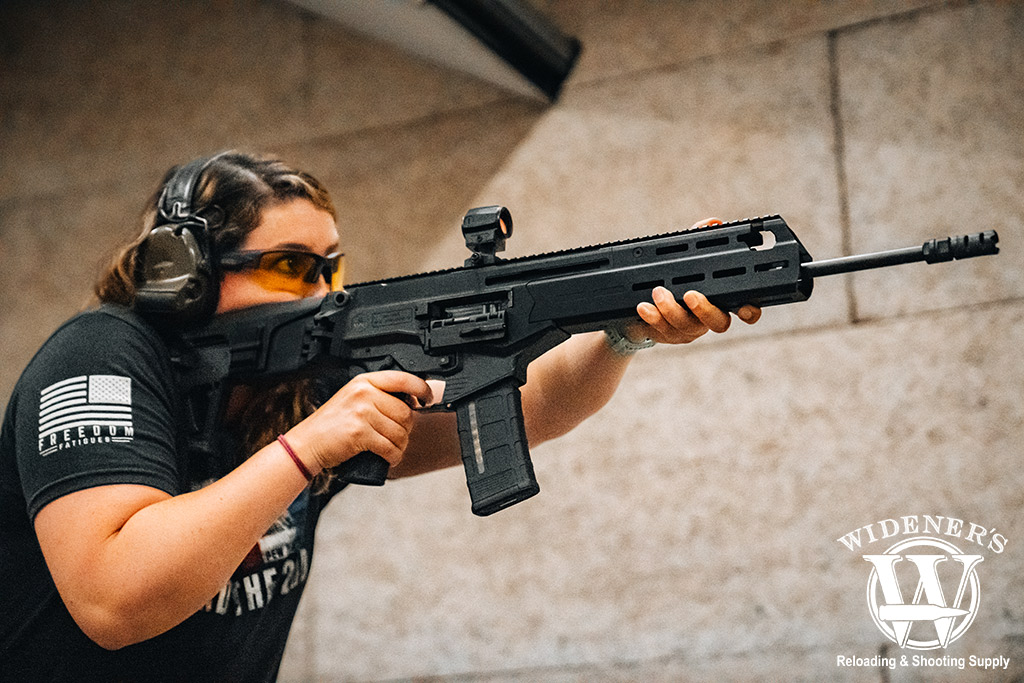
Have you heard of the IWI Carmel? It’s the latest release from IWI, a firearms manufacturer you need to know about if you don’t already. Their story begins in 1933 when IMI (Israel Military Industries) began firearms production in Israel under the British Mandate. It was in the late 1950s that IMI began collaborating with the IDF (Israel Defense Forces) to develop small arms for troops fighting in urban areas and hard environments.
They started to manufacture the wave of innovative products we have come to know. This includes the UZI, Tavor, X95, the Negev machine gun, Galil, and Jericho model firearms. These firearms have been used worldwide by militaries, law enforcement agencies, security personnel, and civilians. In 2005, the small arms division of IMI, Israel Weapon Industries (IWI), was created.
One of the latest firearms from IWI is the all-new Carmel rifle, and they put a lot of time and effort into developing this rifle. I was lucky enough to test-fire one before they went into production. What many people don’t see behind firearms manufacturing is the time – sometimes years – from concept to prototype to final product.
Before releasing any gun, IWI US has professional shooters, high-level instructors, industry writers, and their team of employees put their guns through the testing ringer. They test their firearms with different ammunition and different suppressors if that’s an option, and, as with the Carmel, test the different gas positions.
If the gun doesn’t perform as it should, they return to the drawing board, adjust, and start testing again. The final design of the Carmel is an accurate rifle that is super fun to shoot and a great suppressor host. It’s also fully ambidextrous for any shooter to manipulate the controls.
What’s The Purpose Of The IWI Carmel?

IWI’s Carmel is a semi-automatic, short-stroke, gas-piston rifle with a folding stock. (Credit: Hector Cibrian)
The IWI is a semi-automatic, short-stroke, gas-piston rifle with a folding stock. It’s designed for home defense or as a travel truck gun. Its 16-inch barrel makes it a contender for shooting competitions. It features a proprietary, two-stage trigger with a crisp break and fast reset.
In fact, one of my friends in Arizona has already tested and proven it in competition, and it performed out to 600 yards with no problem. It also shoots sub-MOA even with a suppressor attached to it. After spending a lot of time testing ammunition through it, I’m amazed at how great a suppressor host it is. Finally, who really needs a reason to buy a rifle?
Specifications:
- Action: Semi-auto
- Operating System: 2-position gas regulator, rotating locking bolt
- Magazine Compatibility: AR-15 Magazines
- Barrel Material: Free-floating, Chrome-lined, Cold hammer-forged
- Barrel Length: 16 inches
- Overall Length: 26 3/4″ Stock folded — 33 3/4″ Stock collapsed — 37 1/4″ Stock extended
- Weight: 8lbs 2oz without Magazine
- Rifling: 1:7″ Twist, 6 RH Grooves (5.56 NATO)
- MSRP: $1,799
Is The IWI Carmel Unique?

If you plan on operating the IWI Carmel suppressed, it has an adjustable 2-position gas regulator.
Gas Regulator
The most unique feature of the Carmel is its 2-position gas regulator. There’s a “regular” gas position and a “suppressed” position. Adjusting the gas regulator does not require special tools. You can simply use a bullet tip to rotate it, a punch, a screwdriver, a pen, or really anything that can fit in the hole. This makes it easily serviceable in the field if an adjustment is necessary.
One pro tip is to test-fire the Carmel with whichever suppressor you plan to use and ensure that the rifle functions correctly. Occasionally, some suppressors won’t need to use the suppressed position but will run better in the regular position.
Fully Ambidextrous
There are so few rifles on the market today that are fully ambidextrous. In the last decade, I’ve met more left-handed shooters than I can count. I feel for so many of them who have to manipulate the gun uncomfortably. The IWI Carmel rifle has an ambidextrous safety, magazine release, bolt catch, and non-reciprocating charging handle.
As a right-handed shooter, my absolute favorite feature of the Carmel is the right-side bolt release. I can function the rifle completely with my trigger finger, which is beneficial, especially when reloading the rifle with an empty chamber. There’s no need to search for the left-side bolt release anymore, saving time so I can get my left hand back on the gun to support my shooting after inserting the magazine.
Folded Stock Firing Capability
I have a few folders on my CQB rifles at home, but none are fireable with the stock folded. You can shoot the IWI Carmel with no problem with the stock folded. This feature is a game changer in situations where you might not have time to deploy the stock or shoulder the rifle. I practiced shooting the Carmel from the hip with the stock folded to test its reliability, and I had zero malfunctions. I think this design will intrigue many who rely on rifles as their main defensive weapon.
Compatibility
AR-15 Magazines
The Carmel is 100% compatible with AR-15 magazines, so there’s no need for a proprietary magazine or anything other than what you most likely already have at home. Any NATO MIL-STD 5.56 Steel, aluminum, or polymer magazines will fit. I’ve even test-fired my Carmel with the Magpul D-60 drum, and there are no issues with compatibility. IWI also includes a Gen 3 PMAG with the window.
Scopes & Optics
The Carmel is so very different from the AR-15 that I’m used to, and I’m sure many of you are, too. Typically, you want to mount optics only on the upper receiver and not further out onto the handguard. The reason for this is handguards are less supportive and can shift slightly, impacting your zero.
The Carmel has one continuous rail that gives you many options for mounting a scope, red dot optic, magnifier, light, laser, pressure pad, and more. Not to mention backup flip-up iron sights. I have seen a ton of variability in what Carmel owners have mounted to their guns, which adds to the uniqueness of this rifle. There are also M-LOK accessory rails at the 3, 6, and 9 o’clock positions, so you can add a sling mount point, a Picatinny rail for a bipod, grip panels, and more.
Suppressors
The IWI Carmel is an impressive suppressor host. Not all rifles perform well once a suppressor is mounted. You can occasionally have a shift in your optic’s zero or lose a little bit of accuracy with a suppressor. This was not the case at all with the Carmel. I tried a few different suppressors, but my favorite one on this particular rifle was the Harvester Evo. This suppressor is compatible with .223 Remington/5.56 NATO to .300 Win.
It’s also rated for 16-inch barrels for .223 Remington/5.56 NATO. The Carmel’s barrel is threaded 1/2 x 28. SilencerCo includes a direct thread mount for this thread pitch and a 5/8 x 24 direct thread mount. Due to the design of the Carmel’s barrel, one thing to note when mounting any suppressor onto it is to always use a jam nut.
IWI Carmel Range Test

Foldy Boi: You can reliably run the IWI Carmel in the folded, or extended stock position.
I took the IWI Carmel to the range with the full Widener’s crew, and all of us writers, editors, and videographers got a turn shooting it. We tested it with the stock folded and deployed to see if any malfunctions occurred in either position. It cycled just fine in either position. We went about 300 yards downrange to test-fire the Carmel and shot it offhand, from a kneeling position, and off a bench.
I used a Picatinny mount on a bottom M-LOK slot and mounted my Warne Scope Mounts bipod to set the gun up for the most accurate shots possible. With this configuration, I shot sub-MOA at 100 yards easily, using just 55-grain 223 ammunition. If I had some serious long-range yardage to work with, I would push the Carmel out with some heavier grain bullets like 75 or 77-grain to see just how accurate it is. As I mentioned earlier, I have friends who have put the Carmel through its paces in competition and hit targets at 600 yards with no problem.
Ammo Selection
The one hiccup that occurred on the range came down to ammunition selection. Not every round manufactured will be perfect, even fresh brass factory ammunition. It’s important to run good-quality ammunition through your firearms if you want them to run reliably, last long, and be accurate. I highly recommend case gauging your ammunition if you plan to shoot competitions or use specific defensive rounds in your firearms. The issue was out-of-spec brass that got stuck in the chamber after being fired.
Similarly to ammunition, you need to pair your firearms with good-quality optics. A rifle can only perform as well as the ammo and scope or dot/magnifier combination you choose to use.
Pros of the IWI Carmel
Customizing the Gun
A big pro of the IWI Carmel is the variable length of pull and comb height. If you’re familiar with an AR-15, the position options for a stock rely on the buffer tube. Most stocks don’t come with an adjustable cheek riser. The Carmel has both, which are very generous, allowing you to customize the rifle to your length of pull, eye relief, and where you mount your optics.
Everything Mentioned Above!
To reiterate, the Carmel is the total package. It has ambidextrous controls, a 16-inch accurate shooting barrel, can be fired in the folded position, a 2-position gas regulator, M-LOK rails, and allows the shooter to set the gun up to their shooting style. It’s a feature-rich rifle that’s ready to hit the range out of the box.
Cons of the IWI Carmel
Price
The Carmel comes at a higher price point with all these amazing features. The Carmel’s MSRP is $1,799, which might seem high, but it’s on par with a customized AR-15 (minus the AR having ambi controls). To put the price in perspective, a quality AR-15 will cost anywhere from $1,000 to $1,500. It likely won’t have an ambidextrous safety, magazine release, or bolt catch. You can purchase an aftermarket ambidextrous safety and install it, but that can run another $50 and more if you need a gunsmith to install it.
An adjustable stock such as the LUTH-AR MBA-3 Carbine Buttstock costs north of $200 but allows you to set an AR-15 up to you. You can also change your AR-15’s gas by installing an adjustable gas block. However, this adds to the cost and potentially requires a gunsmith to install it.
One such manufacturer that created a fully ambidextrous AR-15 is American Defensive Manufacturing. Their lowers have fully ambidextrous controls, and their total gun package is $2,200. Another manufacturer that stepped up to make fully ambidextrous rifles is Sig Sauer. Their M400-SDI X-Series rifles are priced at $1,500. We’re also comparing an AR-15 to the Carmel, which is an entirely different design.
Reviewer Experience
I’m coming up on a decade of shooting and reviewing guns. I’ve been blessed with the opportunity to shoot more rounds than most people could ever dream of shooting. I’ve burnt out rifle barrels from high round counts, broken many pistol parts, and have a bin of failed gear at home collecting dust. My friends in the firearms community look to me to see what easily breaks and what’s “Kenzie-proof,” meaning what will actually hold up. All that said, I don’t baby my guns or gear. I truly want to know the inner workings of any firearm I pick up, so I’m the right “tester” for the job.
Something worth noting is the IWI Carmel prototype was brought to an event years ago where I could first put my hands on the rifle. I patiently waited for them to develop the Carmel into what it is today. I’ve been excited about the features and functionality for a while now. At that event, I was able to talk to the team at IWI to understand why the gun was designed the way it was and how it should perform in defensive situations, competition, or for fun on the range. I’m happy to see it in production and in people’s hands.
IWI Carmel: Good To Go?

For your trips to the gun range, your truck gun, or as a home defense rifle, the IWI Carmel is a solid option.
The IWI Carmel is on a short list of my favorite guns I’ve shot or owned. Not many rifles get me excited, but when you start talking about fully ambidextrous controls, I’m in! Adding a suppressor to this gun makes the shooting experience that much sweeter. The Carmel makes a solid truck gun, home defense rifle, or just a good option for anyone struggling to set a rifle up to their length of pull and cheek height.
It may not be the best option for those who want a sporting rifle they can completely customize. However, many parts of the rifle can be swapped out to meet your performance requirements. The proprietary trigger may turn some off, but as I mentioned, it is a very good factory trigger. The standard M-Lok handguard makes adding accessories easy and helps future-proof the overall usability of the rifle. The long Picatinny rail gives you plenty of real estate for mounting optics, iron sights, or both.
If you’re looking for reviews of other battle rifles, be sure to check out the write-up I did on the Wilson Combat AR-10.
The post IWI Carmel Review appeared first on Wideners Shooting, Hunting & Gun Blog.







Leave a Reply